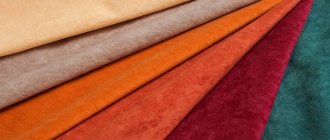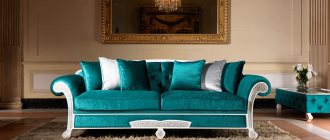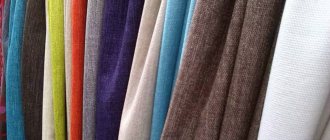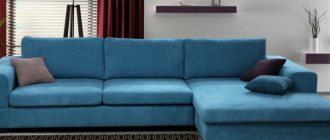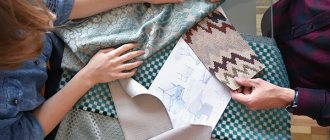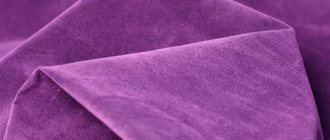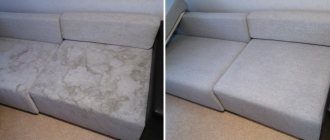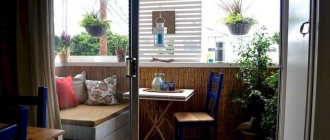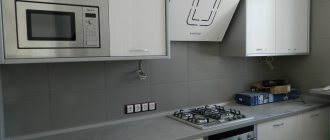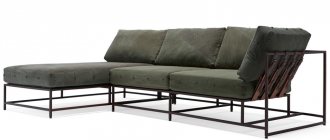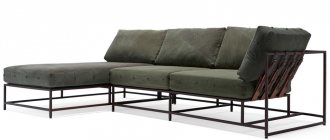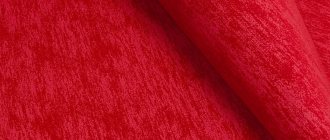The beauty of furniture depends on many factors. An important factor is the fabric upholstery. The quality and characteristics of the fabric determine how long the sofa upholstery will last without pilling, and how easy it will be to remove stains from the upholstery.
We offer a detailed description of the types of materials, their pros and cons, which will help you decide which fabric to choose for upholstery.
Natural types of sofa upholstery
Natural textiles are leaders in the clothing segment due to their unique properties: good air permeability, hypoallergenicity, wear resistance and comfort.
However, for furniture production, all these qualities lose relevance due to the fact that the coating is under heavy load, even taking into account the fact that clothing samples differ in technology.
For upholstery of furniture, natural or mixed fabrics are used with the advantage of the following raw materials:
- cotton and linen. The optimal choice for children's furniture;
- wool. Not the best option. The fabric does not slip, but it itches and is prone to dust accumulation;
- thick silk. Used for reupholstering antique furniture.
Linen and cotton upholstery are a good option for a children's room. Such materials allow air to pass through, do not cause allergies and do not contribute to overheating.
In other cases they are rarely used. More often they are sheathed with textiles of mixed composition. Synthetic and artificial fibers extend the life of upholstery: they suffer less from external influences and are easy to care for.
One of the most comfortable and durable materials is high-quality genuine leather. However, its cost limits the availability of such furniture. Sofas and armchairs, covered with good leather, are status items and emphasize the presentability of the interior.
Suede
A living room or office space will be decorated with upholstered furniture covered with natural suede. But not every consumer can afford such things.
Suede leaves marks if not handled carefully. This material is not suitable for a sofa that serves as a sleeping place and for those who have small children and pets in the house.
Velvet
The refined and pathetic surface of velvet has not lost its relevance for decades. Most consumers, when choosing upholstery, try to ignore this option, and in vain.
The modern textile industry offers many options, different in shades and textures, and in the composition of raw materials. Natural cotton velvet, used in furniture production, is an expensive material that requires delicate care. But in living room sets it looks elegant.
Velvet is not suitable for a sofa that is constantly used as a sleeping place, despite its high wear resistance. To increase the service life of the material, manufacturers impregnate the canvas with special agents that reduce the absorption of moisture and odors and maintain color saturation.
Velvet made from mixed fibers is not inferior in beauty to cotton. Embossing options on the surface of the fabric allow you to choose a suitable interior.
Artificial velvet is an unpretentious fabric that tolerates washing well. Its cost is lower than the price of cotton and mixed samples. Natural velvet coating requires dry cleaning and careful use.
Jacquard
Interior jacquard is one of the most durable and beautiful materials. Its wear resistance is due to the special way the fibers are interwoven during the weaving process. The threads are located close to each other in the fabric, which ensures high density.
Jacquard is a heavy patterned fabric that is beautiful and expensive. The range offered by modern industry is amazing. But the main advantage of jacquard is the durability of the upholstery.
Jacquard fabrics can have a natural composition and include synthetic fibers. The fabric feels dense and slightly slippery to the touch. Considered a classic in residential design.
There are also disadvantages to jacquard upholstery. In addition to the high cost, it is necessary to note the tendency to form snags (due to the way the threads are intertwined) and delicate care. For samples made from natural materials, dry cleaning is required.
Pet owners are not advised to choose jacquard. Cats often leave claw marks on it in the form of elongated threads, which does not have the best effect on the appearance of the furniture.
Silk for sofas
There are practically no competitors for silk in the interior. Noble, refined fabric with a characteristic shine attracts the eye, makes you want to touch and feel the delicacy of the coating.
Despite innovative production methods, silk is not suitable for use as upholstery on furniture intended for daily use. Not everyone can afford such pleasure, but rather only those who put status above practicality.
Silk has always been considered an elite material for upholstery. Today it is used for the restoration of antique armchairs, chairs, and sofas.
If you still want to have upholstered furniture with silk coating in your interior, you should choose mixed, more practical materials with high density. An alternative option is to sew silk covers. They are easier to care for than permanent upholstery.
Tapestry fabric
It has been customary to cover furniture with tapestry fabrics since ancient times. Hand-woven canvases had fabulous prices, and the drawings on them told whole stories.
The relevance of tapestries has not been lost in modern design. The fabric is a type of jacquard woven from thick cotton threads. Some samples contain a small percentage of man-made fibers.
Thanks to the high density and thickness of the material, the upholstery lasts a long time without losing its original attractiveness. The variety of ornaments allows you to decorate the interior in various ways that meet modern trends.
When choosing tapestry fabrics, it is worth considering that too large sofas (for example, double ones) will look tacky. Therefore, tapestry is more suitable for compact pieces of furniture wardrobe.
The high cost is justified by the long service life. Tapestry canvases have a disadvantage - they are not resistant to intense exposure to sunlight, losing their richness of color. This property must be taken into account when planning the placement of furniture relative to windows.
How to choose the right fabric
The glossy surface combines beautifully with the ornate oriental pattern
When choosing a “soft friend” for the living room or bedroom, you need to evaluate not only its visual appeal, comfortable shape and ergonomics. The basis of its beauty and comfort is the textile component. Evaluate the material according to the following criteria:
- Durability . Here it is worth considering whether to choose natural fabric, but fragile, or artificial, but strong
- Origin of the pile. Textiles of animal origin include, for example, pure wool. Plant representatives include cotton, linen, and silk.
- Moisture resistance and hygroscopicity. The first will not allow the liquid to be absorbed, and the second eliminates the possibility that the surface will become damp in conditions of high humidity.
- Anti-vandal coating. Some fabrics are treated with a special solution, which greatly extends its service life
- Tactile sensations are no less important. It’s much more pleasant to rest on soft and smooth hair than on rough and itchy hair.
- Decorativeness . There are matte and glossy materials, plain and colored, with different prints and applications. Find an option that suits your apartment and creates a harmonious interior in the same style
Synthetic types of upholstery
Materials made from artificial fibers are not inferior to natural ones in terms of attractiveness. Their color range is much wider, and their prices are more affordable. The disadvantages include the ability to accumulate static electricity and attract dust. They are easier to care for.
Alcantara or faux suede
A worthy alternative to natural suede is artificial suede. It has a number of advantages:
- higher strength;
- inability to stretch during operation;
- easier to maintain, easy to clean;
- wide choice of colors;
- durability;
- affordable price.
There is also a similarity with natural suede: a velvety surface that is pleasant to the touch.
A new product on the market is a non-woven material that imitates suede. The production technology is simpler, and the price is accordingly affordable. However, in terms of main indicators, non-woven material is significantly inferior to textile material. It is less wear-resistant and short-lived.
Alcantara is an analogue of natural suede, named after the Italian brand that first mastered the manufacturing technology. The cost of this type is high, but the material guarantee is 10 years. It is easy to care for and resistant to external influences.
There are several replicas produced by enterprises in Turkey and China. The names and prices differ, but the service life of the fake is low. Therefore, when choosing, you should inquire about the country of origin of the material.
There are several varieties in the Alcantara production line: with and without backing, fire-resistant, two-color and monotone, with perforations and with ornaments. The consumer is offered more than 100 types of analogues of natural suede intended for upholstered furniture and car seats.
Teflon flock Curtisan
In the line of non-woven materials for upholstery of upholstered furniture and car seats, flock is a popular material - a soft and pleasant-to-touch material. Courtesan fabrics have a distinctive feature: they have high water-repellent properties and resistance to external damage, and the ability to “breathe”.
This material does not burn and is capable of demonstrating anti-vandal qualities. Pets will not be able to tear the coating with sharp claws.
Thanks to these properties, Courtesan flock is used for the production of upholstered furniture for catering establishments and offices.
Chenille fabric
Translated into Russian, “chenille” means “caterpillar”. The fabric received this name due to its structure. During the production process, fluffy fibers are twisted and woven into the fabric. According to the composition of the raw materials, it is divided into cotton, mixed and artificial chenille made from natural fibers, ideal for children's furniture.
Thanks to special technology, the fabric does not stretch, does not absorb odors, and does not wrinkle. Mixed fabrics are not used to cover corner sofas intended to complete kitchen sets. It is recommended to clean this material only with a dry method.
Artificial fur
One of the popular materials is faux fur. The range is very wide: various colors and imitation of noble fur.
When choosing it as a coating, you need to take into account that it is not suitable for intensive use. It is not recommended to cover folding sofas with fleecy fabrics, including faux fur. It is beautiful, but prone to abrasion, and is also difficult to care for.
Technological microfiber
Microfiber (euroflock, microfiber) is one of the most popular interior fabrics. It has several advantages: a wide selection of colors and textures, resistance to pilling; washes easily and does not fade.
Technological microfiber is safe for health, wear-resistant and practical. Despite its high density, the material has the ability to “breathe”. This is one of the most durable coatings used in the furniture industry. In addition to microfiber upholstery, sofa cushions are made.
Nylon fiber is used in the production of the material. Therefore, the canvas does not tolerate hot processing. In furniture items, woven fabrics are mainly used, less often non-woven ones. Microfiber does not accumulate dust and does not cause allergies. Special Teflon impregnations provide it with protection from water, dirt and dust.
Consumer reviews confirm that this material can last a long time without losing its attractiveness.
Anti-vandal fabric Verona
Furniture velor Verona was developed in the USA. Interior fabric is produced in Turkey. Velor fabrics are used as wall coverings. These solutions are dictated by modern design trends and cope well with the anti-claw function.
The soft fleecy surface, variety of colors and absolute resistance to external influences have made Verona popular in Europe and Russia. The properties are due to a unique technology: innovative weaving of fibers and double coating of pile are used in weaving.
The material drapes well, which is why it is widely used in interior design.
Microfiber Panda
Panda represents velor of the highest category made in Turkey with an anti-claw effect. This type of anti-vandal material has a wide color palette: from soft pastel tones to rich colors.
Like any type of artificial velor, it requires special care. When the fabric is exposed to temperatures above 60 degrees, the adhesive base is destroyed, which leads to abrasion and damage to the coating.
Summary
Whatever upholstery you choose for your sofa, remember the following general care rules. They are simple, but if you follow them, even cheap upholstery will last you a long time. What can we say about the road! So:
- do not place the sofa close to the heat source (radiator), do not place heaters nearby;
- do not use cleaning products that are not intended for furniture (especially with bleaches);
- Take care of your sofa regularly and try not to spill anything on it (even if the upholstery is stated to be waterproof).
And - have a nice rest on your new sofa!
Upholstery for sofas made of leather and leatherette
Furniture upholstered in leather looks stylish and presentable. The cost of natural material is very high, and various types of leatherette are an alternative option.
Eco-leather for upholstered furniture
Eco-leather is a material that differs from artificial leather in properties and manufacturing technology. Highly wear-resistant cotton fabrics are used as a base, on which a layer of polyurethane is applied. To increase strength, the surface is coated with Teflon at the final stage.
In appearance, the texture of the material resembles genuine leather, but unlike the latter, it is half the price. Abrasion resistance depends on the thickness of the polyurethane layer. The fabric has the ability to conduct vapors and air, which makes it safe.
Eco-leather can be used in a wide temperature range. Therefore, furniture with such upholstery can be used in open areas in hot weather and in cold weather. One drawback of the material is that if mechanical damage occurs, it is difficult to hide the defect, especially on samples of light shades.
Arpatek leatherette
Arptek is another high-quality imitation of genuine leather. The composition includes polyurethane, polyester, viscose and cotton. Synthetic fabric demonstrates a high degree of abrasion resistance. According to the Martindale test, the sample passed 200 thousand cycles.
Elastic fabric, as close as possible in external characteristics to natural leather, is easy to clean and does not lose its richness of color. But he is afraid of scratches that are not easy to disguise. Therefore, this type of upholstery is not suitable for pet owners.
Genuine furniture leather
Genuine leather is rightfully considered the most prestigious material for furniture upholstery. It is not afraid of intense loads, and mechanical damage appears on the coating in extremely rare cases.
Environmental friendliness and comfort are undeniable. In addition, upholstered furniture looks very expensive and representative. If treated with care, the service life will be more than a dozen years. Sometimes there may be a slight unevenness of color on the surface due to the structure of the fabric (the thickness of the skins is not uniform), but this will not spoil the appearance.
The only obstacle to using genuine leather for upholstery is the high cost of the material.
Textured and pile types of upholstery
In the range of interior fabrics, a significant part is represented by textured materials and fabrics with a pile surface: flock, chenille, velor and many others. etc. When choosing, it is important to pay attention to the composition of the raw materials. It is not recommended to heat treat fabrics containing nylon.
The textured surface is achieved by special weaving of threads (like jacquard) or embossing on non-woven materials. Modern pile upholstery is often applied by spraying. The use of innovative technologies has made it possible to increase wear resistance and extend the service life of these materials.
Anti-vandal flock
The term anti-vandal flock refers to an anti-claw material that has increased strength and resistance to damage. The fabric is produced by gluing nylon fibers onto the front surface of the fabric.
The density of the pile ensures the softness of the material and its strength. The cat's claw cannot damage the surface by sliding off the nylon bristles. Teflon impregnation, used in the production of anti-claw flock, repels water and protects the fabric from dust and dirt.
This type of material is resistant to ultraviolet radiation, it does not fade or fade when cleaned. It is recommended to remove stains from flock without waiting for absorption. Do not clean with alcohol-containing products so as not to destroy the adhesive base. The upholstery should be vacuumed periodically.
It is necessary to take into account the ability of the material to absorb odors, so it is not advisable to cover sofas and chairs for the kitchen with flock.
Soft velor
Unlike flock, velor does not absorb odors, but is not so resistant to external influences. It tolerates cleaning well with a steam generator, does not fade, and does not lose its visual appeal.
The softness and beauty of the velor pile attracts with its sophistication. In terms of care and durability, velor is considered the best material in the mid-price upholstery segment.
The texture is smooth, shaped, embossed. A variety of shades allows you to choose the fabric to suit any interior.
Velor Galaxy
The difference between Galaxy velor and the line of pile fabrics is in the special processing of the fibers at the production stage. Antistretching effect makes the material incapable of stretching during operation.
The “easy cleaning” technology and water-repellent ability have made Galaxy widely used in the production of furniture for cafes, restaurants and other public places.
"Indestructible" matting
Matting is often used for making and upholstering furniture, despite the fact that the material is inferior in softness to other types. This is a type of chenille made from natural fibers (cotton, linen, matting) with the addition of synthetics.
Due to the special weaving, a unique pattern is formed on the surface. The dense material is durable and provides protection against sagging of the packing. It is used for upholstery of kitchen corner sofas, double sofas, children's sofas and in Eurobook models.
The matting does not cause allergic reactions, has the ability to “breathe”, and is easy to care for. In terms of wear resistance it is inferior to other interior synthetic materials, but in terms of safety it surpasses them.
Water-repellent microsuede
Microvelor differs from velor in the structure of the fabric. The fibers of the fabric do not exceed 1 mm, and the weaving is based on cells in the form of a honeycomb, which makes the fabric strong and durable.
Externally, both materials are similar. The water-repellent effect is created by Teflon impregnations, which in addition provide protection against contamination. Nylon or nylon fibers prevent animals from damaging the upholstery with sharp claws.
Which furniture fabric to choose for different rooms
A copy for a children's room
The intensity of its future use depends on the location of the sofa.
- For a children's room you need to buy a product with a natural and environmentally friendly coating: linen, cotton, flock, jacquard. Artificial chenille is popular, as it adequately withstands children's activity and curiosity. The fabric must be water-repellent, washable, not absorb odors, and retain color saturation
- The sofa for the living room should be combined with its style. Usually expensive and spectacular furniture is placed here. Upholstery made of jacquard, tapestry, velor, real leather is suitable
- The kitchen seating area should be upholstered in washable fabric that is easy to clean. It should not be afraid of humidity and strongly absorb odors. Fireproof and anti-vandal impregnation are required
- In a room where the sofa is used as a sleeping place, choose durable materials that do not wear out under intense use. The flock will last a long time, but it is rough to the touch
No cozy living room is complete without a seating area
The upholstery of the sofa is of great importance. They pay no less attention to it than to its size and shape. It can give furniture a solid look, or, conversely, reduce the cost of furnishings.
A soft corner is the central place in any apartment. This is an area where all family members gather together in front of the TV or a board game. Choose the material carefully to extend the life of the “clothes” for your “soft friend” for many years.
Watch a funny video, the authors of which experimentally try to choose the best upholstery for upholstered furniture:
Inexpensive upholstery for sofas
The desire to purchase inexpensive, durable fabric is justified. Based on cost, categories for popular interior paintings are distinguished:
| Category | Name of fabrics |
| A budget option | Matting, microfiber, flock, microcorduroy, cotton chenille, cotton scotchgard |
| average price | Chenille bouclé, velor, faux leather |
| Premium class | Jacquard, tapestry, suede, genuine leather, silk |
Cotton Scotchgard
On the one hand, cotton tape is affordable and considered “rustic” by many. On the other hand, this material is produced by jacquard weaving of threads, which makes it beautiful and durable.
Furniture with such upholstery looks impressive, is practical, and meets safety requirements. But it has disadvantages: it can accumulate odors and is not resistant to cat claws.
Pleasant Boucle
Bouclé is a fabric texture obtained by weaving threads of different characteristics. The fabric is soft, slightly loose with a knotty surface. In the segment of inexpensive upholstery materials, furniture matting with a bouclé effect is popular.
It has good air conductivity and is suitable for any design. The fabric is hypoallergenic, which allows it to be used in children's furniture. It has a minus - low wear resistance and lack of anti-vandal effect (anti-claw).
Anti-claw upholstery fabric
Few people know that the term “anti-claw” is used as a marketing ploy. Sometimes a manufacturer labels interior materials to attract consumer demand. It is worth understanding that the animal loses interest in the upholstery if it cannot catch the thread with its claw. But the character of pets cannot be predicted. Anti-vandal materials for each of them will become an obstacle to “experiments”.
Characteristics of the canvas:
- the weave should be fine and as dense as possible;
- the pile is low, mainly made of synthetic fibers;
- the fabric does not crumble during friction;
- It is preferable to choose smooth fabrics;
- high wear resistance according to the Martindale test.
Summarizing the requirements for anti-vandal fabrics, the most practical samples are:
- artificial suede anti-claw;
- flock;
- velours;
- microfiber;
- corduroy mixed or synthetic.
Select by purpose
After familiarizing yourself with the qualities of each upholstery fabric, you decide on your choice. The first thing you should pay attention to is the purpose of the piece of furniture and the expected service life and intensity.
For children's models
For sofas and armchairs that are planned to become furnishings for a children's room, it is worth giving priority to safety. It is advisable to choose materials made from cotton and linen that are not too wear-resistant for furniture that can be changed as the child grows.
For practical consumers who are not ready to change furnishings after 2-3 years, it is recommended to give preference to cotton upholstery with the addition of synthetic and artificial fibers to increase service life.
To the living room
For living rooms, you should choose expensive and presentable fabrics that are practical and durable.
The intensity of use of furniture pieces is important for choosing in terms of wear resistance.
For the bedroom
Bedrooms will require upholstery with a high abrasion resistance rating. This aspect is important for folding sofas and “Eurobooks”.
If you are prone to allergic reactions, preference is given to mixed materials containing at least 50% natural fibers.
To the kitchen
Upholstery material for kitchen sofas must be protected from moisture and dirt. If there are animals in the house, then the anti-claw effect will guarantee long-term use of the furniture.
It is not recommended to use fabrics with a loose texture (chenille, faux fur, some types of flock and velvet). They get dirty faster and are more difficult to clean. In addition, some materials can absorb odors.
Fabric for upholstery of upholstered furniture is chosen according to its intended purpose.
Types of upholstery fabric
Exterior fabric option
All furniture materials are conventionally divided into several types:
- The thinnest and least wear-resistant. This includes cotton, tapestry, corduroy, suede, lightweight flock, chenille
- Fabrics from the first group, but more dense and durable
- Materials with relief finishing and voluminous texture
- Heavy fabric with high density: thick tapestry and chenille, printed faux suede
- Textiles with natural and environmentally friendly composition. A small percentage of synthetics may be added
- Leatherettes
- Inexpensive real leather
- Noble and expensive genuine leather.
Please note that in the case of sofa upholstery, naturalness and environmental friendliness do not always mean quality and comfort. Such materials rarely have good performance characteristics; they quickly become unusable. The best option would be to choose combination formulations, where the advantages of natural origin are harmoniously combined with the strengths of artificial and synthetic compounds.
